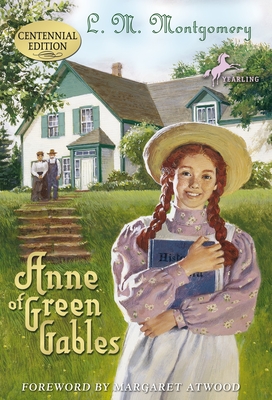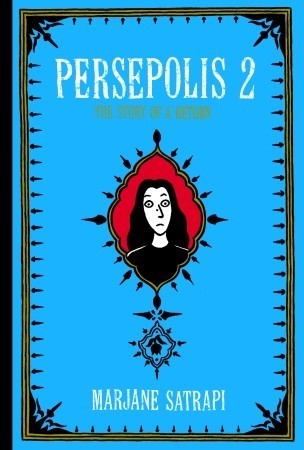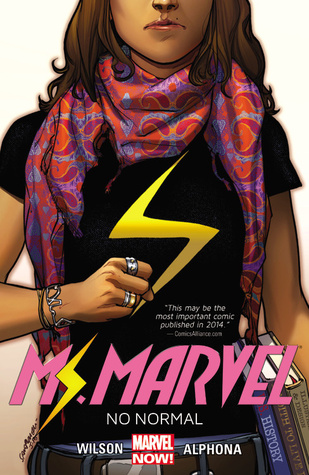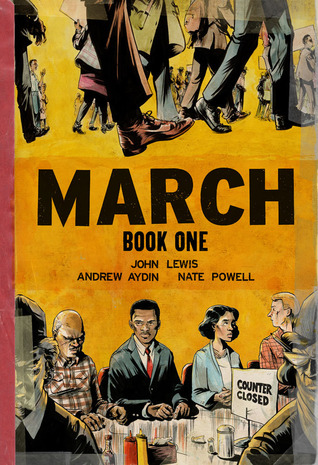Well, this week I finished my MLIS classes at San Jose State iSchool and realized I have not finished a book in a few weeks. So, for this week’s blog, I found this old paper about Scott McCloud’s Understanding Comics. I really enjoyed reading this book and found the information helpful when reading graphic novels/comics. I had not read many, except the funnies in newspapers, before taking a class last semester. So, here is my paper explaining what I learned from the book. Hope you find it interesting.
Scott McCloud’s Understanding Comics
Scott McCloud (1993) explains his understanding of comics and the ‘invisible art’ they represent in his book Understanding Comics: The Invisible Art. Readers are introduced to the basic ideas necessary to understand comics not only as a genre or style but as an art form. McCloud (1993) also discusses what makes comics unique and how readers participate in the art. Comics provide readers with the ability to immerse themselves in art and artists can express their message in a new way.
Comics demand active participation from the readers and make them feel that they are part of the action. They use icons to describe what is taking place, these icons represent many elements both visible and invisible. Comics are more than the sum of their parts making them unique from all other forms of art or literature. McCloud (1994) states that “[i]cons demand our participation to make them work. There is no life [in an icon] …except that which [readers] give to it” (59). The life of comics comes not only from the creators but from the reads and their imaginations.
This giving of life is seen by what takes place not only in the images and words but in the blank space between panels. McCloud (1994) explains that the magic happens in this blank space between panels known as the gutters. The gutters bring the reader into an active role while reading the comics. The reader must supply what takes place between frames to make a complete story. The example offered by McCloud (1994) is two panels one of two men, one with an ax the other scared. The second panel shows the city skyline and the sound “EEYAA!!” leaving the interpretation of what just conspired to the reader (66). Readers infer that there was a murder in the small space between the panels, completing the story in the gutter. Comics rely on readers’ participation to make an exciting story.
Comics also depend on readers to participate voluntarily in the process of closure. This closure allows comics to show the movement of time and space. McCloud (1994) explains it this way “[c]omics panels fracture both time and space, offering a jagged staccato rhythm of unconnected moments. But closure allows us to connect these moments and mentally construct a continuous, unified reality” (67). Closure enables readers to create full scenes from what they are being offered. This important aspect of participation from readers allows comics to flow along a given path and tell a marvelous action packed story which moves the readers to not only see the visible but also the invisible elements of life.
Closure does not only take place between the panels but also within them. Readers have the ability to complete an image in their minds, especially of everyday items, things, or events. When artists chose to only draw a small section of an image in a panel the readers must interpret what is taking place and infer what will happen from it. The mind will not only add additional visual elements but will use memory to add in sounds and smells conveyed by the panels.
This drawing in of the other senses helps comics to create a more real and lifelike world. This world draws readers into it through participation recalling memories, smells, sounds, etc. Comics have methods to represent sound, smell, and emotion. Each method draws readers more into the story allowing for viewer participation, whether voluntary or involuntary. When reading comics, the icons and lines show what is taking place, even if in the real world it would be unseen. McCloud (1994) states that comics are the “[d]ance of the seen and the unseen” (92). The invisible is made visible through the use of lines and icons, images, and words. This dance takes place on the page with readers participating with artists and writers the entire time.
The first of many things made visible by comics is the passage of time. The movement of time does not only take place through the comics but in individual panels. Time is expressed when the readers move their eyes along individual panels and know that certain events take place first. While all characters’ words exist simultaneously on the page, they are not each talking over each other and readers intrinsically know this. A basic understanding of how conversations work allows readers to understand that each word bubble is a single moment in time. The use of word bubbles indicates a flow of time across specific panels with the reader dictating when the “now” is.
Word bubbles are not the only method of showing times passage nor is sound. Time is also shown in the gutters, just like actions. Creators can extend the seen with the addition of more panels along with expanding the space of between the panels. A third way is with the expansion of the panel itself to include more time. Each of these devices allows for the readers to understand that more time is taking place between the panels or actions depicted in them. However, the length of time is still determined by the readers and the images being shown with give some indication as to the length but most often readers infer based on their own everyday experiences (McCloud, 1994, 100-101).
Besides time comics show readers emotion and invoke emotion from the readers. This revelation of the invisible is seen through the art, use of lines and icons, within the panels. Readers again are to participate in the story and feel along with the characters of the comics. The images used in a specific panel can show emotions and when linked to others this effect is heightened. Like time emotion also takes place in the space between the panels through closure supplied by the readers creating it from their own experiences. Each reader may experience different emotions from the panel just as different viewers of a painting will see it in different ways. Colors are used in comics as well to show emotion alongside lines which dictate the invisible emotions to make readers feel them. Along with icons and color backgrounds also provide a strong sense of emotion in comics. These changes in background cause readers to attribute the “feelings not to themselves but to the characters they identify with” (McCloud, 1994, 132). The identifying with a character and ascribing of emotions allows creators to show internal turmoil in a scene without distorting characters and/or affecting the plot of the story.
Comics also create a world where smell and sound are both visible by lines and icons. These images represent the smells and sounds which readers know and can add. Readers know what simple wavy lines (a common icon) emanating off a pipe or pile of garbage indicates, also knowing that while the pipe does emit visible smoke the same lines when seen over garbage do not indicate smoke but smell emanating from the trash (McCloud, 1994, 128). Creators show the invisible with the art they use to tell their stories by combining art and words to create a new kind of art/literature.
Comics have become an art of their own, they are not like their predecessors and have a future not tied to traditional art. While comics are often seen as unworthy to be called literature or art they can be both and yet neither. Comics share a common past with pictorial language, going back centuries to early pictographs and hieroglyphs. They both use icons to share stories, these icons are easily recognizable to readers who interpret them. Just as hieroglyphics were a language comics also are a language (McCloud, 1994). McCloud (1994) explains that comics have vocabulary and grammar. The vocabulary is icons which provide the words for comics. The grammar of comics is supplied by the panels because they hold together all the icons. The panels help readers understand what is happening and how to follow the story. Without the panels, the icons would be a jumble and fall apart causing confusion.
Conditioning of readers on how to read comics also contributes to how comics are understood. Readers know where to start and end on each page, carrying the story from start to finish. This conditioning allows comics to provide a sense of flow and storytelling. Though McCloud (1994) notes that because we are so used to reading in a particular fashion that “…a mischievous cartoonist can play any number of tricks on us” (105). These tricks can add a sense of fun to the comics or allow for readers to take a different path to the end than expected. A change in how viewer participation is perceived can allow for more methods of storytelling and add new elements to the art of comics(McCloud, 1994, 106).
Comics are an art of the invisible showing readers the world in a different light (McCloud, 1994). They show readers what is possible and what is unseen by revealing it through the use of images, icons, and lines. These image and icons are aided by the addition of words and sometimes colors to create a wonderful world where anything is possible. However, comics are not only created by the artists and writers but by the readers themselves when they use closure to fill in the blanks left by the creators. Every time closure takes place, in a panel or between them, readers are drawn into the world which they are helping to create by adding in the missing information from their own imagination. Comics is a welcoming form of art because it “…welcomes any writer or artist to step into its world…” (McCloud, 1994, 197). Artists are welcomed in to begin creating a world all their own. A second aspect of this welcome is extended to all who read and enjoy comics creating a unique partnership. This partnership is between those creating comics and those reading them to create “…something out of nothing, time and time again” (McCloud, 1994, 205). Every time a comic is read a new adventure starts for the one reading it aided by the images, icons, and words placed on the page by an artist and/or writer. Therefore, comics are truly an art form in which “…what you get is what you give” [McCloud, 1994, 137). Comics have something for all who want to read or create them providing expression in an art form uniquely their own.
Reference
Goodreads.com. (2017). Understanding comics: The invisible art (The comic books #1). Retrieved from https://www.goodreads.com/book/show/102920.Understanding_Comics?ac=1&from_search=true
McCloud, S. (1994). Understanding comics: The invisible art. New York: Harper Collins.






























